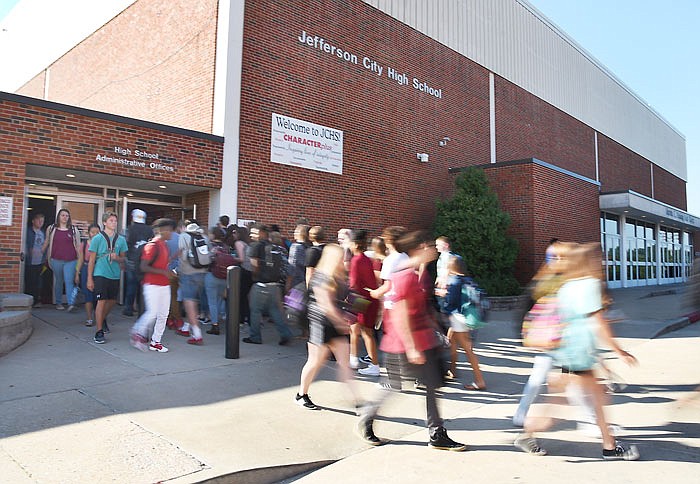Space - Jefferson City High School is running out of it. Building a second public high school appears to be the best solution to the problem, Superintendent Larry Linthacum told about 30 people attending a Jefferson City Area Chamber of Commerce breakfast Friday.
But, he emphasized, the seven-member Board of Education hasn't made a final decision on submitting a bond issue and tax increase plan to voters in April and doesn't have to make that decision until next month.
"We are stronger together, whether we have one high school or two," the second-year superintendent said at the beginning of a 50-minute presentation, citing the slogan the Jefferson City Public Schools has used for more than a year.
"We want to give kids opportunities, and we believe in smaller learning environments," he added. "We think this (two high schools plan) will address that.
"But it does cost money."
The cost of the two schools proposal, "bricks and mortar-wise, is $130 million," Linthacum said.
That includes $40 million for major renovations to Jefferson City High School so, if voters approve the second high school, both schools would have a "new" feel to them.
"It can't be the 'haves' and the 'have-nots'" between the two schools, he said.
The total package would require about a $1.20 increase for each $100 in assessed property value, the superintendent said, "or about $285 to $300 a year raise in your taxes, on a $139,000 house - which is the average, median home in Jefferson City."
Classes will continue even if voters reject the proposal, he said.
But if that happens, Linthacum said trailers will have to be set up on the Simonsen 9th Grade Center's Major Field, because this year's sixth-grade class is very large, and Simonsen doesn't have the room for all of those students in one ninth-grade building.
The added value would be giving twice as many kids the opportunities to participate in non-class activities like sports, music, drama, clubs and others, he added.
Two high schools would have populations around 1,200 to 1,300 students in grades 9-12, Linthacum said, while the current high school has about 1,600 students in grades 10-12, with another 600 at Simonsen.
He said the plan would be for both high schools to provide similar programs and an equal quality education - but to have separate identities, with the new school's colors, mascot and name to be determined with community input.
Linthacum noted the district's Long Range Facilities Committee in 2014 - before he became superintendent last year - proposed the second high school building, a new elementary school on the district's east side, expansion of the Callaway Hills Elementary northeast of Holts Summit and redrawing elementary attendance boundaries.
"This was reaffirmed in September," he reported.
Linthacum also cited a school board decision in the late 1980s the district should look at a second high school "when grades four through six have 700 kids each. This year, we have kindergarten and second, fourth and sixth grades all above 700 kids."
He noted district administrators and the board have been studying a proposal to build a new high school on the 117-acre site along Missouri 179 - just north of the new St. Mary's Hospital - the district bought in 2012, then proposed as the site of one large new high school in a 2013 bond campaign that, Linthacum noted, voters strongly rejected.
He acknowledged the long-range committee's support for a new elementary school on the east side and said the board won't ignore that idea.
"I've been told that was promised in 1967," he said, adding, however, there's currently a greater need to solve the space issues at the high school, Simonsen and middle schools.
Combining the classes in the Simonsen and high school buildings makes Jefferson City High School the largest high school in the state, even though the district is only in the top 20 of the state's largest districts.
He noted the district's nearly 60 percent poverty level - compared with the Wardsville-based Blair Oaks district's 12 percent - also creates extra needs the Jefferson City district must address.
If the school board places a proposal on the ballot next April and at least 57 percent of the voters approve it, construction could begin next summer and be finished enough so freshmen and sophomores could start attending the new school in 2019, Linthacum said.

